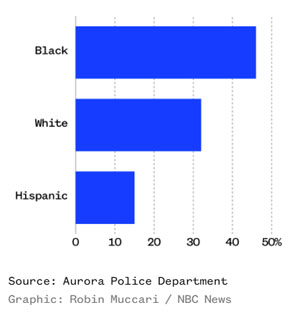Marcus Smith “Died Like an Animal” When Cops Hogtied Him. Police Have Known for Decades It Can Kill
by Amy Goodman
Democracy Now
MAY 26, 2021
https://www.democracynow.org/2021/5/26/ ... th_hogtied
GUESTS
Flint Taylor: a lawyer for the family of Marcus Smith, as well as a founding partner of the People’s Law Office in Chicago.
Joseph Neff: investigative reporter for The Marshall Project.
LINKS
Joseph Neff on Twitter
"'He Died Like an Animal': Some Police Departments Hogtie People Despite Knowing the Risks"
"The Torture Machine: Racism and Police Violence in Chicago"
Despite decades of warnings against the practice, police departments across the country continue to hogtie people during arrests, sometimes with fatal results. On September 8, 2018, Marcus Smith, a 38-year-old homeless Black man in Greensboro, North Carolina, was facing a mental health crisis and asked police officers for help. Instead, eight white officers brutally and fatally hogtied him. Police videos show officers pushed Smith face down on the street and tied a belt around his ankles, then attached it to his cuffed hands so tightly that his knees were lifted off the pavement. Smith’s family filed a lawsuit in 2019 alleging wrongful death, accusing the police department of a cover-up. “The Greensboro Police Department, spearheaded by the chief of police at that time, watched the video and then chose to put out a press release that … ignored and left out the crucial factor that he was hogtied,” says Flint Taylor, one of the lawyers for the Smith family and a founding partner of the People’s Law Office in Chicago. We also speak with Marshall Project reporter Joseph Neff, who says there is little data about instances of police hogtying. “It’s hard to know how extensive it is, because there’s no reporting requirement,” he says.
Transcript
This is a rush transcript. Copy may not be in its final form.
AMY GOODMAN: This is Democracy Now!, democracynow.org, The Quarantine Report. I’m Amy Goodman, with Juan González.
A warning to our listeners and viewers: This next story contains graphic police violence.
We look now at the shocking cover-up of the police killing of Marcus Smith in North Carolina. It was September 8th, 2018, when Smith, a 38-year-old homeless Black man, facing a mental health crisis, asked Greensboro police officers for help. He approached them and asked them to help him. Instead, they brutally and fatally hogtied him. Police body-camera and dashboard-camera video footage shows officers pushing Smith face down into the street and tying a belt around his ankles, then attaching it to his cuffed hands so tightly his knees were lifted off the pavement. This is part of the video footage.
POLICE OFFICER: What’s your name, partner? What’s your name?
MARCUS SMITH: My daddy call —
POLICE OFFICER: What is it?
MARCUS SMITH: I’m Marcus.
POLICE OFFICER: I know.
MARCUS SMITH: My name, Marcus.
POLICE OFFICER: OK.
MARCUS SMITH: Please, sir.
POLICE OFFICER: All right. Just stay here.
MARCUS SMITH: Please. No, sir.
POLICE OFFICER: Just go ahead and sit. Go ahead and grab a seat.
MARCUS SMITH: Man, just help me, man.
POLICE OFFICER: Just grab a seat. Grab a seat.
MARCUS SMITH: Call the ambulance.
POLICE OFFICER: Just grab a seat.
MARCUS SMITH: Call the ambulance, bro. …
POLICE OFFICER: Just take it easy.
POLICE OFFICER: We’re not going to hurt you.
POLICE OFFICER: Take it easy.
POLICE OFFICER: We’re not trying to hurt you. We’re not trying to hurt you. Settle down, bud. Come on. Roll over on your stomach.
MARCUS SMITH: [screaming]
POLICE OFFICER: Roll him the other way, towards you guys. There you go.
POLICE OFFICER: I can’t get my hand under him.
MARCUS SMITH: Help!
POLICE OFFICER: You got the cuffs?
POLICE OFFICER: Well, I did. They’re right here.
POLICE OFFICER: Now, watch your — watch your —
POLICE OFFICER: Take it easy. Take it easy. Take it easy.
POLICE OFFICER: Just watch yourself, because somebody got blood on him.
POLICE OFFICER: Take it easy.
POLICE OFFICER: Come on, bro.
POLICE OFFICER: Give us your other hand behind your —
POLICE OFFICER: Put your other hand behind you.
POLICE OFFICER: Behind your back. We’re not trying to hurt you.
POLICE OFFICER: Put your hand behind you. Hey, put your hand behind you.
POLICE OFFICER: Relax. Relax. Relax. Just relax. We’re trying to help.
POLICE OFFICER: Come on, buddy.
MARCUS SMITH: [screaming and gasping]
POLICE OFFICER: Come on, man. There we go. He’s a character. Come on, bud.
POLICE OFFICER: Is his hand going to get out of the — is there blood?
POLICE OFFICER: I don’t think so.
POLICE OFFICER: Yeah, he’s bleeding somewhere.
POLICE OFFICER: Let’s just go ahead and do this. And if you guys could help me carry him to the truck?
POLICE OFFICER: Yeah.
AMY GOODMAN: Marcus Smith’s family is charging cover-up and filed a lawsuit in 2019 alleging wrongful death.
For more, we’re joined by two guests. In Durham, North Carolina, Joseph Neff is with us. He’s an investigative reporter for The Marshall Project who examines the deaths of Marcus Smith and others across the country in a new report headlined “'He Died Like an Animal': Some Police Departments Hogtie People Despite Knowing the Risks.” And in Chicago, Flint Taylor is with us, one of the lawyers for the Marcus Smith family, founding partner of the People’s Law Office in Chicago.
We welcome you both to Democracy Now! Flint Taylor, start off by continuing to describe that night, where Marcus approached eight white police officers and asked them for help. Within minutes, he would be dead.
FLINT TAYLOR: Thank you, Amy. It’s great to be on with you and Juan and also to follow Professor Hinton.
I can’t see the video as you showed it, but just listening to it, as I have watched it several times, of course, it makes me completely upset. I’m sure that it’s tremendously traumatizing to not only people who are watching, but to the family.
What happened in that case was that these eight white police officers decided that they were going to hogtie Marcus Smith. And this wasn’t something that was unusual in the Greensboro Police Department. We have, in our lawsuit, documented that in the past five years, before the hogtying of Marcus Smith that caused his death, 275 people were hogtied by the Greensboro Police Department and that 68 or 69% of those people were African American, and over 15% of them were suffering a mental crisis, such as what Marcus was suffering.
But what happened in the case, after Marcus died in the hospital — or, actually, lost his breath and stopped breathing, and his heart stopped on the street there — the Greensboro Police Department, spearheaded by the chief of police at that time, watched the video and then chose to put out a press release that, like the first press release up in Minneapolis, ignored and left out the crucial factor that he was hogtied — what they called, in the parlance of the police department, maximum restraint. So they put out a press release that made it sound like Marcus had collapsed: He was suicidal, and he was agitated, and he just collapsed in police custody.
And that was the start of a cover-up that has continued in various forms, has been perpetrated and continues to be perpetrated not only by the police department, but by all of the politicians — many of the politicians — the mayor, the City Council, the city attorney and others in Greensboro. And, of course, as you mentioned, we have had a civil suit that we’ve been dealing with for the past two years. We have taken statements and depositions of all the main actors in the case, all the police, the chief of police, the mayor, the city manager. And what’s happening now is that the city wants to put all of that testimony and all of our arguments about why it should not be secret under seal, and they want to hold us in contempt for what they say is disseminating information, information that’s not confidential, information that should be in the public domain. They want to hold us in contempt, and, unbelievably, they want to bar us from practicing law in the state of North Carolina.
And so, that’s where we stand now in this remarkable case, a case that should be looked at along with the George Floyd case and so many other cases where unnecessary and brutal restraint is used. And it’s starting to come to light, thanks to people like Joe Neff at The Marshall Project and you, Amy, so that people can see and understand the breadth of racist police violence in this country.
JUAN GONZÁLEZ: And, Joseph Neff, I’d like to ask you. Your investigation uncovered at least 23 deaths that have occurred in the past decade from people being hogtied by police departments across the country. Could you talk about how extensive this practice is?
JOSEPH NEFF: Well, it’s hard to know how extensive it is, because there’s no reporting requirement. For example, in Greensboro, where Marcus Smith died, police do not view the hogtie as a use of force, so they don’t even count it within their own department. We made public records requests from the country’s 30 biggest police departments on use of force, every type of use of force, and we got records back from about 11 of them. So, it’s really hard for the public to know. To find these 23 people who died while being hogtied, we looked in court records. We looked for news stories. That was the — we just had to scrape the web like that to find these cases.
JUAN GONZÁLEZ: And could you talk about how many departments permit this, or which ones don’t?
JOSEPH NEFF: Well, out of the top 30 departments that we surveyed, the 30 largest, 22 of them explicitly forbid this practice. Another four — Charlotte, Houston, Indianapolis and one other — allow it under different circumstances. So, it’s hard to — I would say that the practice is more common in smaller police departments. The big ones — New York has banned this practice for decades.
AMY GOODMAN: I wanted to turn to another case. In 2017, Vanessa Peoples was doing laundry in the basement of her Aurora, Colorado, home when police officers showed up for a child welfare check. Peoples told NBC, who you did this project with, Joe, what happened next.
VANESSA PEOPLES: The next thing I knew, they threw me down on the ground, and they had my arm behind my back. And I kept telling them, I said, “There’s something wrong. My arm doesn’t feel right. It hurts.” And he had his knee in my back. And it was like, at that moment, I felt like I was going to lose my life.
AMY GOODMAN: I mean, this is Vanessa Peoples describing this, Joe. And this is Aurora. That’s where Elijah McClain would be killed a few years later, and then another woman describing the same thing happening to her. She was hogtied in front of her neighbors. And can you also talk about the hobble?
JOSEPH NEFF: The hobble is the actual strap that police use to wrap around someone’s ankles, and then they attach it either to the handcuffs or to, in the case of Vanessa Peoples, to a belt around her waist. If you showed this picture to any person in a Walmart parking lot, they would look at it and say, “Oh, that’s a hogtie,” because the feet are pulled up behind the person’s back, and the person is handcuffed behind their back. So, there’s a slight difference in that the hobble is used without attaching to the handcuffs sometimes. But it’s still — if you look at it, it’s virtually the same position.
And Vanessa Peoples, she shouted out seven times during while she was restrained, while they were restraining her, that she couldn’t breathe. And then, you’re right, they took her out, and eventually she was laying in her front yard for all her neighbors to see like that.
JUAN GONZÁLEZ: And, Flint Taylor, I wanted to ask you. You mentioned the efforts of the officials to get you — to run you out of North Carolina. But in terms of the — what kind of attacks has the Smith family had to deal with since they sought to find justice for Marcus?
FLINT TAYLOR: Well, Juan, I first want to commend the wonderful strength that Mary Smith, the mother of Marcus Smith, and the father and the sister, Kim and George, have shown, from the moment that they saw the video that revealed that their son had been hogtied. It wasn’t 'til a month later that the video was shown to the Smith family. Mary couldn't watch it, but George watched it. And that’s the first time that anyone knew, outside of the police department and the powers that be, that there was a hogtie. They had completely covered up not only the fact that he was hogtied, but the video itself. They hadn’t released it. They hadn’t moved to release it to the public.
From that moment that the family learned what actually happened to Marcus to this present day, Mary Smith, particularly, and the family, generally, has stood behind justice for Marcus Smith. And I want to say that there’s a remarkable movement on the ground in Greensboro, that is a multiracial, a multigenerational movement, that appears at every City Council meeting and asks questions about what in fact is being done about this case. They stand in front of City Hall every Monday — Mondays for Marcus — with banners calling for justice in the Marcus Smith case. And one of the things that the — what’s being demanded by the movement on the ground there is that there be a full apology from the mayor and the City Council for the death of Marcus Smith, there be a memorial for Marcus Smith in the city of Greensboro, and there be just compensation for the family.
The City Council and the mayor have been doing a lot of different diversionary tactics, a lot of misinformation publicly, including slandering the family, and particularly Mary Smith, who is the plaintiff in our lawsuit. We’ve been trying to fight back publicly. And that’s when they came down on us and said, “We can talk, but you can’t.” And I think that it raises — not only does the hogtying and the idea of the different kinds of prone restraints that are used across this country that being so dangerous because of positional asphyxia and sudden death syndrome and all those kinds of activities, but also now we’re looking at an attack on lawyers, an attack on the community, which they are singling out, as well as the community activists who have spoken up — a First Amendment attack.
AMY GOODMAN: Flint, you mentioned Kim Smith, Marcus’s sister. This is Kim speaking to NBC about the treatment of her brother.
KIM SUBER: Imagine your closest sibling, looking at them die. … I had no idea what a hogtie was. I had no clue. That’s how you treat an animal.
AMY GOODMAN: So, looking at this nationally, the scores of people who have died with this use of the hobble, no centralized database about how it is used, Joe Neff, the responses of the police departments to your repeated requests to explain what their policies are?
JOSEPH NEFF: Some departments were very helpful. And actually, in Aurora, they released the data. They actually released on the types of restraints that they were using. So, that is how we were able — is one of the few cities where we could actually count the times the hobble was used. And to their credit, in the —
AMY GOODMAN: We have 15 seconds.
JOSEPH NEFF: OK. Their credit, the police chief has denounced the practice and fired the officer who hobbled Shataeah Kelly and left her in the well of a car for a drive down to the police station. She has denounced it.
AMY GOODMAN: An astounding story, which you write about in your Marshall Project piece, “'He Died Like an Animal': Some Police Departments Hogtie People Despite Knowing the Risks.” We will link to it. Joe Neff, thanks so much for being with us, and also Flint Taylor, lawyer for Marcus Smith’s family, with the People’s Law Office in Chicago. This is Democracy Now! I’m Amy Goodman, with Juan González. Stay safe. Wear a mask.
Marcus Smith “Died Like an Animal” When Cops Hogtied Him.
2 posts
• Page 1 of 1
Re: Marcus Smith “Died Like an Animal” When Cops Hogtied Him
“He Died Like an Animal”: Some Police Departments Hogtie People Despite Knowing The Risks
The U.S. Department of Justice in 1995 warned that people may die when police tie handcuffed wrists to bound ankles.
by Joseph Nett and Emily Siegel
The Marshall Project
FILED 4:00 p.m. 05.24.2021
ILLUSTRATIONS BY MARK NERYS FOR THE MARSHALL PROJECT
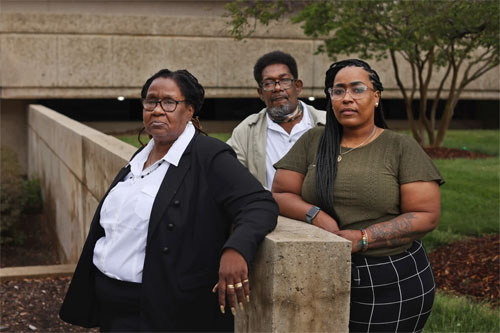
Marcus Smith's parents, Mary and George, and his sister, Kim Suber, outside City Hall in Greensboro, N.C. "The only thing Marcus wanted was help,” his father said.Travis Dove / for The Marshall Project
GREENSBORO, N.C. — On a warm October day in 2018, George and Mary Smith drove to police headquarters, where they had a 2 p.m. appointment to watch video of the death of their son Marcus.
This investigation was published in partnership with NBC News.
Nearly everything they knew about the September 2018 incident in which he died came from a Greensboro Police Department press release, which said he had been suicidal and combative before collapsing as police tried to help him. A lawyer had secured their right to watch the body camera footage.
When they got to headquarters, Mary changed her mind.
“A mother doesn’t want to see her child fall off a bicycle, much less getting beat to death,” she said. “And that’s when I decided I did not want to watch."
George watched the video, and left headquarters convinced police had lied about his son’s death.
https://www.themarshallproject.org/2021 ... -the-risks
Early on Sept. 8, 2018, Marcus Smith was in distress and asked Greensboro police officers for help. They ended up hogtying him. GREENSBORO POLICE DEPARTMENT
"It was terrifying, the only thing Marcus wanted was help,” he said. “I don’t know where they got the suicidal or combative or collapsing from. I didn’t see none of that.”
Like George Floyd under the knee of Minneapolis Police Officer Derek Chauvin, an autopsy found Smith was killed by positional asphyxia, though not by a knee on the neck, but by a controversial and widely banned practice called the “hogtie.”
The video showed that Marcus Smith was in distress and begging police to take him to the hospital or call an ambulance.
Officers pushed him face down on the street and tied a belt around his ankles and attached it to his cuffed hands so tightly his knees were lifted off the pavement. On the video, his last coherent words were “Help me.”
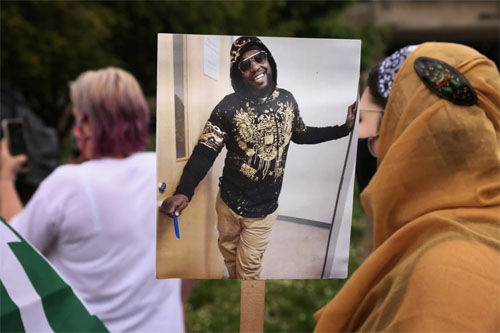
A protester holds Marcus Smith's picture during a demonstration outside City Hall on May 3, 2021, in Greensboro, N.C.Travis Dove / for The Marshall Project
“That’s how my brother died,” said Kimberly Smith, his younger sister, who watched the video later. “He died like an animal.”
Hogtying is a troublesome word and a dangerous act. It involves putting a person on his stomach and tying his cuffed hands to his bound feet behind his back with an adjustable nylon belt, a device known as a “hobble.” Police officers have said the hogtie position is used to restrain individuals who can’t be restrained any other way and would otherwise pose a danger to themselves and those around them. The hobble device can be used to restrain someone's legs without placing them in the compromised hogtie position.
The Department of Justice warned against hogtying as far back as 1995, in a bulletin instructing police how to prevent deaths in custody. The paper instructed officers to move the suspect off his stomach as soon as he was handcuffed, and included this directive: “Never tie the handcuffs to a leg or ankle restraint.”
Use of a hobble device
The hobble, a nylon rope device intended to restrain the legs of someone combative, can also be used to place them in a dangerous position known as a hogtie. Police department policies on using the hobble vary. In Aurora, Colo., the hobble device is approved for officers to use, while the hogtie position is not.
Unapproved hogtie position (Feet are tied to handcuffs or hands; Resting pose is in a bow shape, which makes it harder to breath)
Approved use of hobble device (Rope attached to waist and placed under handcuffs; Body able to lie flat [Experts say the person should be immediately turned on their side, and not left face down.]
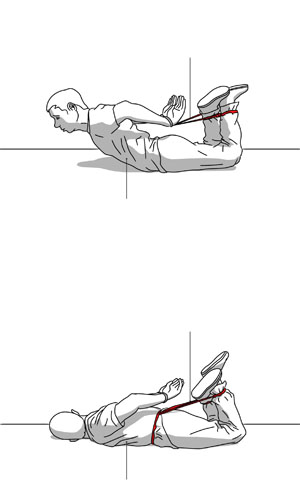
Source: Aurora Police Training Academy. Graphic: Robin Muccari / NBC News
Many police departments, including New York and Los Angeles, have banned hogtying for decades. But a joint investigation by NBC News and The Marshall Project found that a dangerous practice roundly rejected by experts has persisted in many places because of outdated guidelines and lax oversight. And the use of the hobble and hogtie may be even more widespread than can be determined because there are no national reporting requirements and many police departments don’t keep track.
Nationwide, NBC News and The Marshall Project identified at least 23 deaths involving hogtying or a hobble in law enforcement custody since 2010. From California to Maine, police have appeared to use a hobble to either tie a person’s hands and feet together behind them, put pressure on their back with body weight, or leave them prone for longer than recommended. Those cases include a chemical engineer in Mississippi who police said was acting strangely after taking LSD; an unarmed man running naked through his Alabama hometown; and a man who died on a Tacoma, Washington, sidewalk after police deemed his actions suspicious. At least 13 people were mentally ill or in mental crises. Of those who died, 12 were White, nine were Black, and two were Hispanic.
Many departments do not track the use of the hobble device, or when it is used to hogtie, in their use-of-force data. But in those that do keep records, the hobble has been used hundreds of times in recent years.
Over the past five years, police in Aurora, Colorado, have used the hobble on roughly 350 people, nearly half of whom were Black. In Greensboro, court records show that in the four years before the death of Marcus Smith, Greensboro police used a hobble device to hogtie at least 275 people, two-thirds of whom were Black.
Tom Manger, former police chief in Montgomery County, Maryland, and former president of the Major Cities Chiefs Association, says that in his 42 years as an officer he’s only seen the hobble used a handful of times.
“It should only be used when you have a situation where a person is violently combative [and] you have a lawful reason to take them into custody,” said Manger. “What you're trying to do is make sure they don't hurt themselves, or hurt someone else.”
He himself has never used one.
“Cops need to be careful if they're doing something like hobbling somebody,” said Manger. “They'd better be damn sure that they're doing things right.”
'That's not something I would ever do'
The roughly 18,000 police departments in the U.S. have different policies, procedures and training.[/b] Most of the nation’s largest police agencies tend to show awareness that the hogtie is dangerous, but not all ban it.
NBC News and The Marshall Project reviewed the policy manuals for departments in the 30 largest cities in the U.S.
Twenty-two have clear language prohibiting hogtying or attaching hands and feet behind a person’s back.
But in Charlotte, North Carolina; Columbus, Ohio; Houston and Indianapolis, officers are allowed to restrain a person in this manner in certain circumstances or with certain provisions.
Charlotte Police Department policy advises officers to avoid hogtying, but does not forbid it. Columbus police officers are told to make sure to provide slack in the rope that ties the hands and feet together. In Houston, only officers who are specifically trained in the technique can use it. Indianapolis warns officers to closely monitor people who have their legs and arms restrained behind the back.
In the Boston and Milwaukee manuals, there is no mention of hogtying or the hobble device. When questioned, both departments said they do not provide officers with a hobble.
The manuals in Nashville and Detroit have no language that directly addresses hobbles or hogtying.
There’s a reason for these discrepancies. In addition to the lack of national reporting requirements, many departments avoid using the word hogtie. They use phrases like maximal restraint, four-point restraint, hobble, RIPP Hobble or Total Appendage Restraint Procedure (TARP).
To avoid injury, according to the DOJ’s 1995 bulletin, it’s essential to move the person on his side and off his stomach as quickly as possible.
But there is no federal standardized way to use the hobble and there are various points within the process where an error could be deadly. Departments have used different policies; some allowed the hands and feet to be tied together, while others instructed the cuffs to be attached to a belt around the waist. The tying of the hobble, the positioning of the person, and their subsequent transport can all contribute to injury or death.
Joelle DeVane owns the company that makes the original hobble device, the RIPP Hobble.
She said the hobble is a safe tool when correctly used by properly trained officers trying to restrain suspects who are kicking uncontrollably.

A RIPP Hoble. Travis Dove / for The Marshall Project
“The feet are a very powerful weapon and the legs are a very powerful weapon, especially if you have someone that is in an excited state,” DeVane said.
DeVane noted that the instructions that accompany the RIPP Hobble say "NEVER Hog-Tie a Prisoner."
The hobble carries many risks, according to Keith Taylor, a 23-year veteran of the NYPD and now a professor at John Jay School of Criminal Justice. Officers know next to nothing about a person’s health, and there are serious outcomes when police immobilize an unhealthy person in a high-stress situation. Obesity, heart conditions, and drugs all can raise the chances of death.
Taylor says creating federal best practices that agencies must follow would improve police interactions with the communities they serve.
He said the only time police should use any type of maximal restraint is for people who are "not just belligerent, but dangerously resistant to being arrested."
During Taylor’s entire career the NYPD trained officers not to hogtie.
“Personally, I would not use hogtying ever,” said Taylor. “That’s not something I would ever do. Not just because it’s banned, because it’s not safe.”
'He was treating me like a slave'
Hobble is not a word in common parlance, but it’s known in many police circles. Derek Chauvin asked for a hobble as he restrained George Floyd. The officers didn’t use one, however.
Vanessa Peoples had never heard the word before she was tied up with one.

Vanessa Peoples outside her home in Aurora, Colo., where in July 2017, police put her in a hobble and placed her face down on the ground. KEVIN MOHATT/NBC NEWS
Peoples said she was doing laundry in the basement of her Aurora, Colorado, home in 2017 while her two young children were upstairs. She didn’t hear Aurora Police officers banging on her door. A few days earlier, she said, her son had temporarily wandered away from a relative who was supposed to be watching him at a party in a park, so the police were there with a social worker to do a child welfare check.
Police entered the unlocked door. Body camera footage shows one officer entering the basement with her gun drawn.
When Peoples went upstairs, she said her living room was filled with law enforcement. On the video, an officer told her three times to stand back; each time Peoples said no.
The video shows that an officer grabbed Peoples by the neck and pushed her into the wall and then onto the floor face down. He straddled her legs and handcuffed her wrists behind her back. He tied her feet with a hobble and attached them to a belt around her waist. The whole time Peoples screamed for her mother and children. Seven times she told the officers she couldn’t breathe.
Body camera footage shows that they carried her out by her arms and shoulders and put her in a police vehicle and then on the front lawn. They eventually removed the restraints and took her to jail. An officer said in the police report that he heard a “pop” from Peoples’ shoulder and that she was taken to the hospital. Peoples says her arm was dislocated.
Peoples hired a lawyer, but before they filed suit the city settled the case for $100,000. Aurora Police say this does not admit fault. The city did not respond to a request for comment.
“When you feel that you’ve got to get a rope and just tie someone up like that, that's not being treated as human,” said Peoples.
Four years later, Peoples still feels embarrassed that her neighbors saw her bound and screaming on her front lawn. She is wary of the police.
“The pain that I endured going through this, it's unexplainable because I have to walk around every day with that on my mind.”

Vanessa Peoples poses for a portrait with her sons Tamaj (7), Mahjae (6) and Zamari (11 months) outside her home in Aurora, CO, May 13, 2021. KEVIN MOHATT/NBC NEWS
Two years later, and three days after the death of Elijah McClain at the hands of the same police department, Aurora Police were once again in the spotlight for misuse of the hobble on a Black woman.
Shataeah Kelly was arrested by Aurora Police in August 2019 on charges resulting from a fight. An officer decided to hobble Kelly after she tried to escape from his patrol car.
Police video shows that the officer placed Kelly in the backseat with her hands cuffed behind her back. Her bound ankles were pulled behind her back and attached with a hobble to a belt around her waist.
She fell to the floor of the car. Kelly said she couldn’t breathe and asked to be moved but her pleas were ignored and she stayed, stuck on the floor, face down, for the 20-minute drive to the police station.
“I just didn’t know they could do that,” said Kelly. “I just feel like it was because I was Black and he was treating me like a slave.”
Then-Interim Chief of Police Vanessa Wilson, who is now chief, called the incident “egregious” and fired the officer.
“I was sick to my stomach. And then I turned to anger,” said Chief Wilson in an interview. “Because that's not how we train and that's not how we treat people. And it's not how I expect my officers to behave.”
Kelly has retained counsel, the same lawyer who is representing Elijah McClain’s family in its ongoing suit against the city and city employees.
NBC News and The Marshall Project reviewed use-of-force data from the Aurora Police Department obtained via a state open records request and found the agency used the hobble on roughly 350 people over the past five years.
Police used the hobble on Black suspects slightly more frequently than on others. Thirty-nine percent of the suspects arrested by Aurora police in the past five years were Black, but Black people made up 43 percent of the people on whom Aurora police used force — and 46 percent of the people subjected to the hobble.
In 16 percent of the roughly 350 hobble incidents, the person was injured and required medical treatment.
As more scrutiny has been placed on Aurora’s use of the hobble in recent years, the directives in the department’s manual have changed and become more detailed.
In 2016, department policy advised police to avoid hogtying. In the most recent version, issued in late 2020 after the two incidents and one settlement, the policies clearly forbid hogtying. The department is replacing the hobble with a device that doesn’t allow legs to be bent backwards. “I think it’s also just sort of a more humane way of taking someone into custody if they are agitated,” said Wilson.
'Please take me to jail'
As a Greensboro music festival wound down in the early hours of Sept. 8, 2018, Marcus Smith approached a group of eight White police officers on traffic duty and ran frantically from officer to officer, begging for help.
Smith can be heard and seen on police body camera footage saying, “Please take me to jail.” “Call the ambulance bro!” “Take me to the hospital!” “Help me!” “Please sir, I’m going to kill myself.” “Lock me up please.”
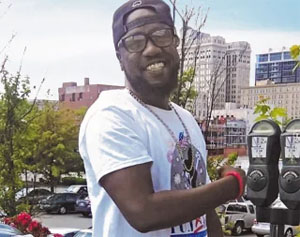
Marcus Smith. Courtesy Beloved Community Center
After several minutes, police put him in the back seat of a cruiser. No one got in the driver’s seat. Smith, not yet handcuffed, became more agitated and rolled on his back. A body camera captured one officer worrying aloud that Smith might break his window.
“We should definitely RIPP Hobble him,” the officer said. “Is anyone willing to help?”
Greensboro policy allowed officers to tie a person’s hands and feet together when they needed a higher level of restraint than handcuffs, but the policy did not define when this higher level of restraint was necessary or appropriate. Training materials warned officers that “Arrestee face down and ‘hogtied’ (knee bend greater than 90°) in transit” was a dangerous position that could lead to positional asphyxia.
Police pulled Smith from the car and put him face down in the street. Smith protested, yelling, “No, you can’t do that, I ain’t resisting.” At least four officers held him down, cuffed him behind his back, strapped the hobble around his ankles and attached it to the handcuffs. Body camera video showed it took officers two minutes and 40 seconds to hogtie him before they stood up as Smith lay face down and motionless.

The site where Marcus Smith was hogtied by police.Travis Dove / for The Marshall Project
“Are you still with us?” an officer asked Smith as soon as the hogtie was complete. He knelt down, put two fingers on Smith’s neck and couldn’t find a pulse. Smith was declared dead an hour later after failed attempts to revive him.
Over the next few hours, Police Chief Wayne Scott watched body camera video before issuing a press release about officers trying to help: “While officers were attempting to transport him for mental evaluation, the subject became combative and collapsed.”
Smith’s friends and family were suspicious. Marcus was homeless and struggled with substance abuse, but they knew him as unfailingly polite and upbeat. Nine days after his death, an outreach worker for the homeless wrote Scott and the city council and asked “how such a beautiful life could come to such an abrupt end.” The letter requested the public release of body camera video and all pertinent information, and said, “Chief Scott, we need answers.”
The chief replied via email two days later that there was nothing to worry about. He wrote that after reviewing videos, autopsy reports and other evidence, he concluded the officers “acted appropriately and with great compassion while trying to help a citizen in need."
An internal investigation found no violation of policy and Scott returned all the officers to active duty.
After viewing the body camera video, however, the Smith family believed there was a cover-up that had begun with the chief’s first press release. Kimberly Smith called the release “a plain lie,” and insisted her unarmed brother posted no threat to eight armed officers. “Why didn’t they just handcuff him?”
On Nov. 30, 2018, the state medical examiner released the final autopsy results. The death was ruled a homicide, caused by “sudden cardiopulmonary arrest due to prone restraint.”
A few hours later, Scott issued a special order reversing department policy. Officers can no longer connect bound feet or ankles to handcuffs.
The Smith family filed a lawsuit in April 2019 alleging wrongful death and a cover-up. The mayor declined to comment for this story. Scott, who has since retired, did not respond to emails or a certified letter requesting comment. The Greensboro Police Department declined to answer any questions because of the ongoing lawsuit.
For two years, officials have fought the case vigorously and have denied wrongdoing or a cover-up in court filings and in depositions. They have argued that the restraint was appropriate in light of the safety risk Smith posed to himself or others.
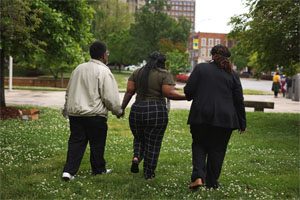
Marcus Smith's parents and sister outside City Hall in Greensboro, N.C.Travis Dove / for The Marshall Project
Marcus’ mother, Mary Smith, said she does not believe police intended to kill her son. They were negligent, treated her son like a throwaway, she said, and should be convicted of manslaughter.
“A lot of Black men would not walk up to eight White police officers at night and say, ‘I’m in trouble, I’m on drugs, I need help,’” she said. “He was looking for help, and he went to the right people. And they killed him.”
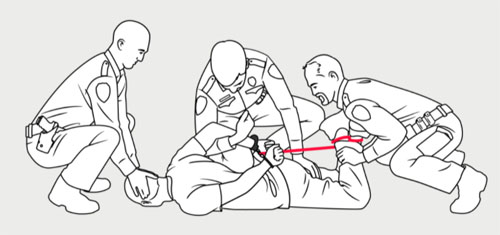
The U.S. Department of Justice in 1995 warned that people may die when police tie handcuffed wrists to bound ankles.
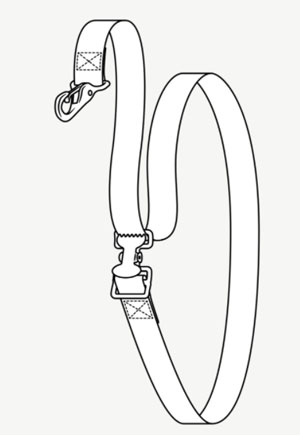
The hobble restraint is typically a webbed belt with a loop and self-locking clip. The strap is long enough to bind the ankles to handcuffed wrists or a waist belt. Tying the hobble only around the ankles allows for transporting people in a seated, upright position — preventing them from kicking. But some police use it while people are facedown on the ground.
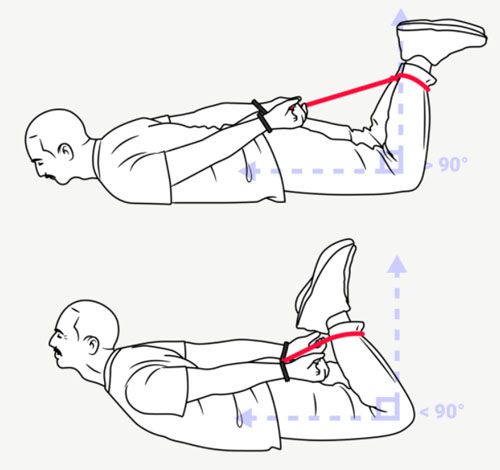
In a full hogtie, the hobble can be tied to varying degrees of tautness, putting pressure on the diaphragm and making it harder for the person to breathe. The U.S. Department of Justice has warned for decades that officers should never tie the handcuffs to a leg or ankle restraint.

The hobble can be tied in several variations — to the handcuffs, but also to the waist. Experts say the person should immediately be turned on their side, and not left facedown, which is dangerous.
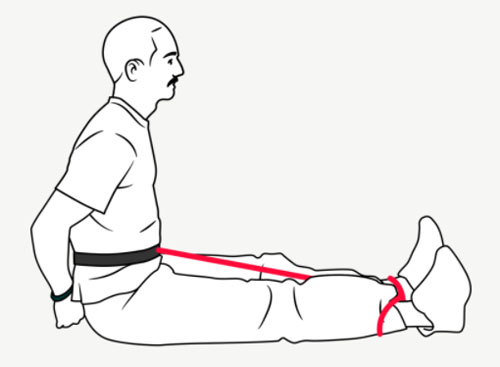
Police say that at times, officers must restrain individuals who can’t be secured any other way and who would otherwise pose a danger to themselves and those around them. Experts say this non-prone position allows police to transport people without the risks of hogtying them.
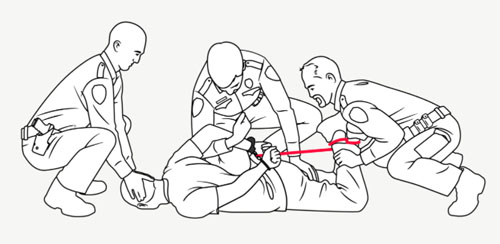
Generally, it can take three or more officers several minutes to get someone down into a hogtie.
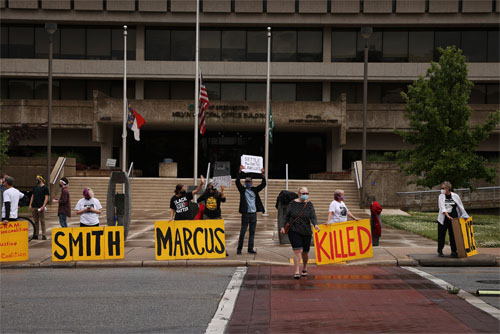
Demonstrators gather outside City Hall in Greensboro, N.C., on May 3, 2021 to protest the death of Marcus Smith after police hogtied him in September 2018. TRAVIS DOVE FOR THE MARSHALL PROJECT
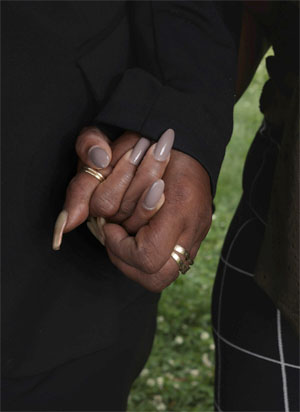
From left: Marcus Smith's mother, Mary Smith; father, George Smith; and sister, Kim Smith, outside of City Hall in Greensboro, N.C., on May 3, 2021. Marcus Smith's mother, Mary Smith and sister, Kim Smith, hold hands during a protest. TRAVIS DOVE FOR THE MARSHALL PROJECT

A protester at a May 3, 2021 demonstration holds a picture of Marcus Smith, who died after police hogtied him on a Greensboro, N.C. street in September 2018. TRAVIS DOVE FOR THE MARSHALL PROJECT
The U.S. Department of Justice in 1995 warned that people may die when police tie handcuffed wrists to bound ankles.
by Joseph Nett and Emily Siegel
The Marshall Project
FILED 4:00 p.m. 05.24.2021
ILLUSTRATIONS BY MARK NERYS FOR THE MARSHALL PROJECT

Marcus Smith's parents, Mary and George, and his sister, Kim Suber, outside City Hall in Greensboro, N.C. "The only thing Marcus wanted was help,” his father said.Travis Dove / for The Marshall Project
GREENSBORO, N.C. — On a warm October day in 2018, George and Mary Smith drove to police headquarters, where they had a 2 p.m. appointment to watch video of the death of their son Marcus.
This investigation was published in partnership with NBC News.
Nearly everything they knew about the September 2018 incident in which he died came from a Greensboro Police Department press release, which said he had been suicidal and combative before collapsing as police tried to help him. A lawyer had secured their right to watch the body camera footage.
When they got to headquarters, Mary changed her mind.
“A mother doesn’t want to see her child fall off a bicycle, much less getting beat to death,” she said. “And that’s when I decided I did not want to watch."
George watched the video, and left headquarters convinced police had lied about his son’s death.
https://www.themarshallproject.org/2021 ... -the-risks
Early on Sept. 8, 2018, Marcus Smith was in distress and asked Greensboro police officers for help. They ended up hogtying him. GREENSBORO POLICE DEPARTMENT
"It was terrifying, the only thing Marcus wanted was help,” he said. “I don’t know where they got the suicidal or combative or collapsing from. I didn’t see none of that.”
Like George Floyd under the knee of Minneapolis Police Officer Derek Chauvin, an autopsy found Smith was killed by positional asphyxia, though not by a knee on the neck, but by a controversial and widely banned practice called the “hogtie.”
The video showed that Marcus Smith was in distress and begging police to take him to the hospital or call an ambulance.
Officers pushed him face down on the street and tied a belt around his ankles and attached it to his cuffed hands so tightly his knees were lifted off the pavement. On the video, his last coherent words were “Help me.”

A protester holds Marcus Smith's picture during a demonstration outside City Hall on May 3, 2021, in Greensboro, N.C.Travis Dove / for The Marshall Project
“That’s how my brother died,” said Kimberly Smith, his younger sister, who watched the video later. “He died like an animal.”
Hogtying is a troublesome word and a dangerous act. It involves putting a person on his stomach and tying his cuffed hands to his bound feet behind his back with an adjustable nylon belt, a device known as a “hobble.” Police officers have said the hogtie position is used to restrain individuals who can’t be restrained any other way and would otherwise pose a danger to themselves and those around them. The hobble device can be used to restrain someone's legs without placing them in the compromised hogtie position.
The Department of Justice warned against hogtying as far back as 1995, in a bulletin instructing police how to prevent deaths in custody. The paper instructed officers to move the suspect off his stomach as soon as he was handcuffed, and included this directive: “Never tie the handcuffs to a leg or ankle restraint.”
Use of a hobble device
The hobble, a nylon rope device intended to restrain the legs of someone combative, can also be used to place them in a dangerous position known as a hogtie. Police department policies on using the hobble vary. In Aurora, Colo., the hobble device is approved for officers to use, while the hogtie position is not.
Unapproved hogtie position (Feet are tied to handcuffs or hands; Resting pose is in a bow shape, which makes it harder to breath)
Approved use of hobble device (Rope attached to waist and placed under handcuffs; Body able to lie flat [Experts say the person should be immediately turned on their side, and not left face down.]

Source: Aurora Police Training Academy. Graphic: Robin Muccari / NBC News
Many police departments, including New York and Los Angeles, have banned hogtying for decades. But a joint investigation by NBC News and The Marshall Project found that a dangerous practice roundly rejected by experts has persisted in many places because of outdated guidelines and lax oversight. And the use of the hobble and hogtie may be even more widespread than can be determined because there are no national reporting requirements and many police departments don’t keep track.
Nationwide, NBC News and The Marshall Project identified at least 23 deaths involving hogtying or a hobble in law enforcement custody since 2010. From California to Maine, police have appeared to use a hobble to either tie a person’s hands and feet together behind them, put pressure on their back with body weight, or leave them prone for longer than recommended. Those cases include a chemical engineer in Mississippi who police said was acting strangely after taking LSD; an unarmed man running naked through his Alabama hometown; and a man who died on a Tacoma, Washington, sidewalk after police deemed his actions suspicious. At least 13 people were mentally ill or in mental crises. Of those who died, 12 were White, nine were Black, and two were Hispanic.
Many departments do not track the use of the hobble device, or when it is used to hogtie, in their use-of-force data. But in those that do keep records, the hobble has been used hundreds of times in recent years.
Over the past five years, police in Aurora, Colorado, have used the hobble on roughly 350 people, nearly half of whom were Black. In Greensboro, court records show that in the four years before the death of Marcus Smith, Greensboro police used a hobble device to hogtie at least 275 people, two-thirds of whom were Black.
Tom Manger, former police chief in Montgomery County, Maryland, and former president of the Major Cities Chiefs Association, says that in his 42 years as an officer he’s only seen the hobble used a handful of times.
“It should only be used when you have a situation where a person is violently combative [and] you have a lawful reason to take them into custody,” said Manger. “What you're trying to do is make sure they don't hurt themselves, or hurt someone else.”
He himself has never used one.
“Cops need to be careful if they're doing something like hobbling somebody,” said Manger. “They'd better be damn sure that they're doing things right.”
'That's not something I would ever do'
The roughly 18,000 police departments in the U.S. have different policies, procedures and training.[/b] Most of the nation’s largest police agencies tend to show awareness that the hogtie is dangerous, but not all ban it.
NBC News and The Marshall Project reviewed the policy manuals for departments in the 30 largest cities in the U.S.
Twenty-two have clear language prohibiting hogtying or attaching hands and feet behind a person’s back.
But in Charlotte, North Carolina; Columbus, Ohio; Houston and Indianapolis, officers are allowed to restrain a person in this manner in certain circumstances or with certain provisions.
Charlotte Police Department policy advises officers to avoid hogtying, but does not forbid it. Columbus police officers are told to make sure to provide slack in the rope that ties the hands and feet together. In Houston, only officers who are specifically trained in the technique can use it. Indianapolis warns officers to closely monitor people who have their legs and arms restrained behind the back.
In the Boston and Milwaukee manuals, there is no mention of hogtying or the hobble device. When questioned, both departments said they do not provide officers with a hobble.
The manuals in Nashville and Detroit have no language that directly addresses hobbles or hogtying.
There’s a reason for these discrepancies. In addition to the lack of national reporting requirements, many departments avoid using the word hogtie. They use phrases like maximal restraint, four-point restraint, hobble, RIPP Hobble or Total Appendage Restraint Procedure (TARP).
To avoid injury, according to the DOJ’s 1995 bulletin, it’s essential to move the person on his side and off his stomach as quickly as possible.
But there is no federal standardized way to use the hobble and there are various points within the process where an error could be deadly. Departments have used different policies; some allowed the hands and feet to be tied together, while others instructed the cuffs to be attached to a belt around the waist. The tying of the hobble, the positioning of the person, and their subsequent transport can all contribute to injury or death.
Joelle DeVane owns the company that makes the original hobble device, the RIPP Hobble.
She said the hobble is a safe tool when correctly used by properly trained officers trying to restrain suspects who are kicking uncontrollably.

A RIPP Hoble. Travis Dove / for The Marshall Project
“The feet are a very powerful weapon and the legs are a very powerful weapon, especially if you have someone that is in an excited state,” DeVane said.
DeVane noted that the instructions that accompany the RIPP Hobble say "NEVER Hog-Tie a Prisoner."
The hobble carries many risks, according to Keith Taylor, a 23-year veteran of the NYPD and now a professor at John Jay School of Criminal Justice. Officers know next to nothing about a person’s health, and there are serious outcomes when police immobilize an unhealthy person in a high-stress situation. Obesity, heart conditions, and drugs all can raise the chances of death.
Taylor says creating federal best practices that agencies must follow would improve police interactions with the communities they serve.
He said the only time police should use any type of maximal restraint is for people who are "not just belligerent, but dangerously resistant to being arrested."
During Taylor’s entire career the NYPD trained officers not to hogtie.
“Personally, I would not use hogtying ever,” said Taylor. “That’s not something I would ever do. Not just because it’s banned, because it’s not safe.”
'He was treating me like a slave'
Hobble is not a word in common parlance, but it’s known in many police circles. Derek Chauvin asked for a hobble as he restrained George Floyd. The officers didn’t use one, however.
Vanessa Peoples had never heard the word before she was tied up with one.

Vanessa Peoples outside her home in Aurora, Colo., where in July 2017, police put her in a hobble and placed her face down on the ground. KEVIN MOHATT/NBC NEWS
Peoples said she was doing laundry in the basement of her Aurora, Colorado, home in 2017 while her two young children were upstairs. She didn’t hear Aurora Police officers banging on her door. A few days earlier, she said, her son had temporarily wandered away from a relative who was supposed to be watching him at a party in a park, so the police were there with a social worker to do a child welfare check.
Police entered the unlocked door. Body camera footage shows one officer entering the basement with her gun drawn.
When Peoples went upstairs, she said her living room was filled with law enforcement. On the video, an officer told her three times to stand back; each time Peoples said no.
The video shows that an officer grabbed Peoples by the neck and pushed her into the wall and then onto the floor face down. He straddled her legs and handcuffed her wrists behind her back. He tied her feet with a hobble and attached them to a belt around her waist. The whole time Peoples screamed for her mother and children. Seven times she told the officers she couldn’t breathe.
Body camera footage shows that they carried her out by her arms and shoulders and put her in a police vehicle and then on the front lawn. They eventually removed the restraints and took her to jail. An officer said in the police report that he heard a “pop” from Peoples’ shoulder and that she was taken to the hospital. Peoples says her arm was dislocated.
Peoples hired a lawyer, but before they filed suit the city settled the case for $100,000. Aurora Police say this does not admit fault. The city did not respond to a request for comment.
“When you feel that you’ve got to get a rope and just tie someone up like that, that's not being treated as human,” said Peoples.
Four years later, Peoples still feels embarrassed that her neighbors saw her bound and screaming on her front lawn. She is wary of the police.
“The pain that I endured going through this, it's unexplainable because I have to walk around every day with that on my mind.”

Vanessa Peoples poses for a portrait with her sons Tamaj (7), Mahjae (6) and Zamari (11 months) outside her home in Aurora, CO, May 13, 2021. KEVIN MOHATT/NBC NEWS
Two years later, and three days after the death of Elijah McClain at the hands of the same police department, Aurora Police were once again in the spotlight for misuse of the hobble on a Black woman.
Shataeah Kelly was arrested by Aurora Police in August 2019 on charges resulting from a fight. An officer decided to hobble Kelly after she tried to escape from his patrol car.
Police video shows that the officer placed Kelly in the backseat with her hands cuffed behind her back. Her bound ankles were pulled behind her back and attached with a hobble to a belt around her waist.
She fell to the floor of the car. Kelly said she couldn’t breathe and asked to be moved but her pleas were ignored and she stayed, stuck on the floor, face down, for the 20-minute drive to the police station.
“I just didn’t know they could do that,” said Kelly. “I just feel like it was because I was Black and he was treating me like a slave.”
Then-Interim Chief of Police Vanessa Wilson, who is now chief, called the incident “egregious” and fired the officer.
“I was sick to my stomach. And then I turned to anger,” said Chief Wilson in an interview. “Because that's not how we train and that's not how we treat people. And it's not how I expect my officers to behave.”
Kelly has retained counsel, the same lawyer who is representing Elijah McClain’s family in its ongoing suit against the city and city employees.
NBC News and The Marshall Project reviewed use-of-force data from the Aurora Police Department obtained via a state open records request and found the agency used the hobble on roughly 350 people over the past five years.
Hobble restraints in Aurora, Colo., by race and ethnicity
Between 2015 and 2020, police performed hobble restraints roughly 350 times. Of those, about one in six resulted in an injury.
Source: Aurora Police Department. Graphic: Robin Muccari / NBC News
Police used the hobble on Black suspects slightly more frequently than on others. Thirty-nine percent of the suspects arrested by Aurora police in the past five years were Black, but Black people made up 43 percent of the people on whom Aurora police used force — and 46 percent of the people subjected to the hobble.
In 16 percent of the roughly 350 hobble incidents, the person was injured and required medical treatment.
As more scrutiny has been placed on Aurora’s use of the hobble in recent years, the directives in the department’s manual have changed and become more detailed.
In 2016, department policy advised police to avoid hogtying. In the most recent version, issued in late 2020 after the two incidents and one settlement, the policies clearly forbid hogtying. The department is replacing the hobble with a device that doesn’t allow legs to be bent backwards. “I think it’s also just sort of a more humane way of taking someone into custody if they are agitated,” said Wilson.
'Please take me to jail'
As a Greensboro music festival wound down in the early hours of Sept. 8, 2018, Marcus Smith approached a group of eight White police officers on traffic duty and ran frantically from officer to officer, begging for help.
Smith can be heard and seen on police body camera footage saying, “Please take me to jail.” “Call the ambulance bro!” “Take me to the hospital!” “Help me!” “Please sir, I’m going to kill myself.” “Lock me up please.”

Marcus Smith. Courtesy Beloved Community Center
After several minutes, police put him in the back seat of a cruiser. No one got in the driver’s seat. Smith, not yet handcuffed, became more agitated and rolled on his back. A body camera captured one officer worrying aloud that Smith might break his window.
“We should definitely RIPP Hobble him,” the officer said. “Is anyone willing to help?”
Greensboro policy allowed officers to tie a person’s hands and feet together when they needed a higher level of restraint than handcuffs, but the policy did not define when this higher level of restraint was necessary or appropriate. Training materials warned officers that “Arrestee face down and ‘hogtied’ (knee bend greater than 90°) in transit” was a dangerous position that could lead to positional asphyxia.
Police pulled Smith from the car and put him face down in the street. Smith protested, yelling, “No, you can’t do that, I ain’t resisting.” At least four officers held him down, cuffed him behind his back, strapped the hobble around his ankles and attached it to the handcuffs. Body camera video showed it took officers two minutes and 40 seconds to hogtie him before they stood up as Smith lay face down and motionless.

The site where Marcus Smith was hogtied by police.Travis Dove / for The Marshall Project
“Are you still with us?” an officer asked Smith as soon as the hogtie was complete. He knelt down, put two fingers on Smith’s neck and couldn’t find a pulse. Smith was declared dead an hour later after failed attempts to revive him.
Over the next few hours, Police Chief Wayne Scott watched body camera video before issuing a press release about officers trying to help: “While officers were attempting to transport him for mental evaluation, the subject became combative and collapsed.”
Smith’s friends and family were suspicious. Marcus was homeless and struggled with substance abuse, but they knew him as unfailingly polite and upbeat. Nine days after his death, an outreach worker for the homeless wrote Scott and the city council and asked “how such a beautiful life could come to such an abrupt end.” The letter requested the public release of body camera video and all pertinent information, and said, “Chief Scott, we need answers.”
The chief replied via email two days later that there was nothing to worry about. He wrote that after reviewing videos, autopsy reports and other evidence, he concluded the officers “acted appropriately and with great compassion while trying to help a citizen in need."
An internal investigation found no violation of policy and Scott returned all the officers to active duty.
After viewing the body camera video, however, the Smith family believed there was a cover-up that had begun with the chief’s first press release. Kimberly Smith called the release “a plain lie,” and insisted her unarmed brother posted no threat to eight armed officers. “Why didn’t they just handcuff him?”
On Nov. 30, 2018, the state medical examiner released the final autopsy results. The death was ruled a homicide, caused by “sudden cardiopulmonary arrest due to prone restraint.”
A few hours later, Scott issued a special order reversing department policy. Officers can no longer connect bound feet or ankles to handcuffs.
The Smith family filed a lawsuit in April 2019 alleging wrongful death and a cover-up. The mayor declined to comment for this story. Scott, who has since retired, did not respond to emails or a certified letter requesting comment. The Greensboro Police Department declined to answer any questions because of the ongoing lawsuit.
For two years, officials have fought the case vigorously and have denied wrongdoing or a cover-up in court filings and in depositions. They have argued that the restraint was appropriate in light of the safety risk Smith posed to himself or others.

Marcus Smith's parents and sister outside City Hall in Greensboro, N.C.Travis Dove / for The Marshall Project
Marcus’ mother, Mary Smith, said she does not believe police intended to kill her son. They were negligent, treated her son like a throwaway, she said, and should be convicted of manslaughter.
“A lot of Black men would not walk up to eight White police officers at night and say, ‘I’m in trouble, I’m on drugs, I need help,’” she said. “He was looking for help, and he went to the right people. And they killed him.”

The U.S. Department of Justice in 1995 warned that people may die when police tie handcuffed wrists to bound ankles.

The hobble restraint is typically a webbed belt with a loop and self-locking clip. The strap is long enough to bind the ankles to handcuffed wrists or a waist belt. Tying the hobble only around the ankles allows for transporting people in a seated, upright position — preventing them from kicking. But some police use it while people are facedown on the ground.

In a full hogtie, the hobble can be tied to varying degrees of tautness, putting pressure on the diaphragm and making it harder for the person to breathe. The U.S. Department of Justice has warned for decades that officers should never tie the handcuffs to a leg or ankle restraint.

The hobble can be tied in several variations — to the handcuffs, but also to the waist. Experts say the person should immediately be turned on their side, and not left facedown, which is dangerous.

Police say that at times, officers must restrain individuals who can’t be secured any other way and who would otherwise pose a danger to themselves and those around them. Experts say this non-prone position allows police to transport people without the risks of hogtying them.

Generally, it can take three or more officers several minutes to get someone down into a hogtie.

Demonstrators gather outside City Hall in Greensboro, N.C., on May 3, 2021 to protest the death of Marcus Smith after police hogtied him in September 2018. TRAVIS DOVE FOR THE MARSHALL PROJECT

From left: Marcus Smith's mother, Mary Smith; father, George Smith; and sister, Kim Smith, outside of City Hall in Greensboro, N.C., on May 3, 2021. Marcus Smith's mother, Mary Smith and sister, Kim Smith, hold hands during a protest. TRAVIS DOVE FOR THE MARSHALL PROJECT

A protester at a May 3, 2021 demonstration holds a picture of Marcus Smith, who died after police hogtied him on a Greensboro, N.C. street in September 2018. TRAVIS DOVE FOR THE MARSHALL PROJECT
- admin
- Site Admin
- Posts: 36135
- Joined: Thu Aug 01, 2013 5:21 am
2 posts
• Page 1 of 1
Return to Slavery 2.0: Racist Cops and the Prison Industrial Complex
Who is online
Users browsing this forum: No registered users and 2 guests

